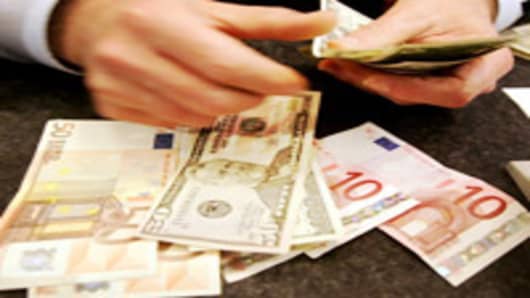The dollar rose Friday as investors scaled back bets for another aggressive Federal Reserve interest rate cut next week and on optimism a $150 billion stimulus package would help support the U.S. economy.
Sentiment was fragile, however, and U.S. stocks cut their gains late in the morning and safe-haven Treasury bond prices rose, reflecting considerable uncertainty about the near-term outlook.
The Fed's emergency 75 basis point interest rate cut on Tuesday, precipitated by sharp falls in global stocks, prompted investors to price in a half-percentage point reduction from the central bank at next week's scheduled meeting.
But losses in European stocks markets on Monday are now being largely linked to fallout from a trader scandal at the French bank Societe Generale which Fed policy-makers were apparently unaware of.
Rate futures suggested 64 chance of a 50 basis point reduction in the fed funds rate target to 3 percent at the upcoming policy meeting. This was down from a 76 percent probability on Thursday.
"The market now only expects another 25 basis points cut out of the Fed. The feeling is that the worst of the panic has passed for the time being," said Boris Schlossberg, senior currency strategist at DailyFX.com in New York.
"The whole idea of U.S. interest rates going down substantially has been taken off the table and that's tempering any further euro gains, giving the dollar a little bit of strength."
The euro dropped to a session low of $1.4685, according to Reuters data. Some traders cited profit-taking ahead of the weekend.
Yield Advantage for Euro
With the European Central Bank's main interest rate at 4 percent and monetary authorities maintaining their hawkish inflation rhetoric, aggressive Fed easing would further undermine the dollar's yield appeal against the euro.
The dollar raced to an intraday peak of 107.89 yen as the tax stimulus package calmed fears the United States would slip into recession and led global stocks higher. But it trimmed gains as U.S. stocks surrendered gains to last trade 0.4 percent higher at 107.25 yen.
"The combination of monetary and fiscal stimulus has the market thinking that the U.S. economy will be able to pull out of its slump and if not, the U.S. government has made it clear that a second wave would be coming," said David Powell, currency strategist at IDEAglobal in New York.
Against the Swiss franc, the dollar rose. Higher yielding currencies such as the British pound and Australian dollar rose marginally against the greenback.
Sterling gained, while the Australian dollar also climbed.
Weaker-than-expected consumer inflation data held the Canadian dollar down against the greenback as it backed expectations of a rate cut from the Bank of Canada.
The dollar was up versus the Canadian dollar.
A heavy data week awaits investors next week, including the January nonfarm payrolls, which could decide the direction of the recession debate.
"The big critical difference between a recession and slowdown is going to be the labor market. As long as labor markets remain in positive territory, the threat of recession may recede," said DailyFX.com's Schlossberg.
"But if we see another weak nonfarm payrolls, all bets are off."


